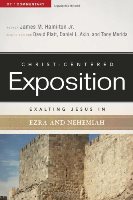Reviewed by David Murray
Why read Ezra and Nehemiah?
Jim Hamilton takes that often-whispered question by the scruff of the neck right at the beginning of his new commentary on these books in the Christ-Centered Exposition series in order to persuade us of the benefits and blessings of studying these much neglected Old Testament books.
He makes a good case throughout, but you only have to read a chapter or two of Jim’s book to be convinced. This is Christ-centered Exposition at its finest, demonstrating that even the toughest Old Testament books have spiritual riches stored up in them if we have a good miner to help us dig for them, and Jim is certainly that.
Each chapter follows the same basic pattern:
Title: A succinct, catchy, but accurate heading for the passage.
Text: Usually one or two chapters from Ezra or Nehemiah.
Main idea: A one-sentence summary of the chapter’s message.
Outline: A simple descriptive outline of the chapter(s).
Introduction: A “hook” to draw you into the passage, often with some contemporary point-of-contact.
Need: A paragraph identifying a spiritual need that this text meets.
Context: The events that led up to this chapter.
Preview: A description of what to expect in the passage.
The exposition is then arranged under the outline headings, and closes with an applicatory conclusion and some questions for further study or discussion.
So what makes this commentary different to any other on Ezra and Nehemiah? I would sum it up with one word: connection. Five kinds of connection, in fact.
It connects people to Scripture.
Jim has a gift of drawing the reader into the ancient world. Although Ezra’s and Nehemiah’s times and places are so different to our times and places, you’ll soon feel as if you are wandering through the dereliction of Jerusalem, tasting the dust and smelling the smoldering rubble. You’ll start rooting for the heroes and hissing at the villains as the vivid descriptions bring them alive in your imagination. Instead of the all-too-common rush to application, there’s an appropriate lingering in the original context that lays the essential foundation for deep and lasting spiritual change.

It connects Scripture to people.
I hope you can already see from the book’s organization that this is a commentary with a passion to connect Scripture to people’s lives. Despite the chasm of 2000-plus years between the books and today, Jim builds numerous sturdy bridges to help the reader cross over from the challenges of that dusty history to better face the difficulties of the digital age.
It connects Scripture to Scripture.
Anyone who is familiar with Jim’s work, knows his remarkable knowledge of the whole Bible, and his skillful ability to connect the dots of Biblical theology. I don’t think I’ve ever come across an Old Testament commentary that does this so well. In almost every chapter he demonstrates how the authors of these books connected the past with the present, using the language of past biblical events to refuel the people and recharge their vision for the present challenges. In doing so, Jim not only trains us read Ezra and Nehemiah better, but also the whole Bible.
It connects Scripture to Christ.
But the connections are not only backward in the past tense; they are also forward in the future tense too. Jim highlights how Ezra and Nehemiah built a Messianic momentum and expectation by kindling the restored community’s hope of an even greater restoration through the Messiah’s reign.
Just as the authors linked their day with the great glory days of Israel’s past by portraying their return from exile as a new exodus, so they also encouraged hope of even greater glory days in the future when there would be a superlative exodus and return from exile.
It’s beautiful to see how the New Testament authors also pick up this language to present the first and second comings of Christ as the climactic fulfillment of this pattern of exodus and return from exile.
It connects people to God.
There are a couple of areas where I don’t align with Jim – for example I take a more continuationist view of the Sabbath principle. Also, my view of the Holy Spirit’s indwelling of Old Testament believers would also make me write some parts of this commentary differently. However, this commentary connected me with God, it brought me into His presence, it made me love the Bible more, and it made me want to serve my Savior better. What more can you ask for from a book?
David Murray is Professor of Old Testament and Practical Theology at Puritan Reformed Theological Seminary and Pastor Grand Rapids Free Reformed Church in Grand Rapids.
You may also like to see our interview with the author of this book, James M. Hamilton.
